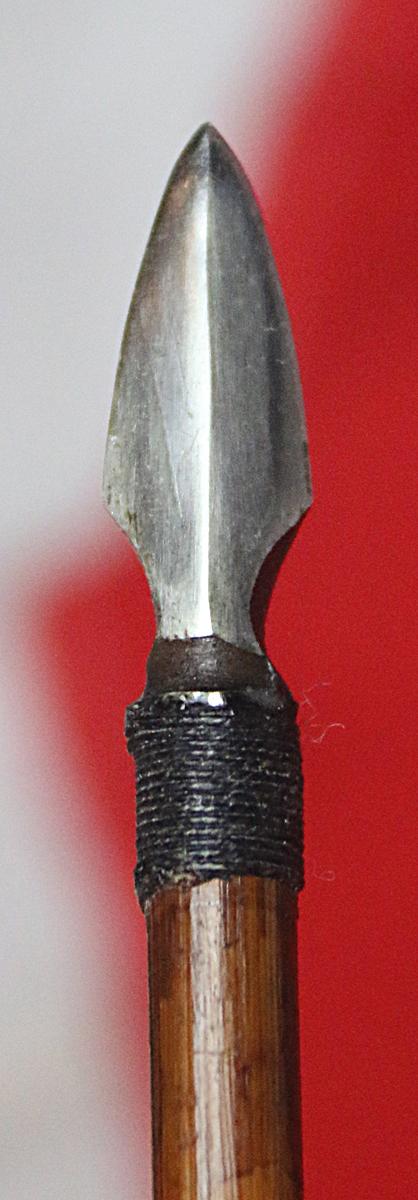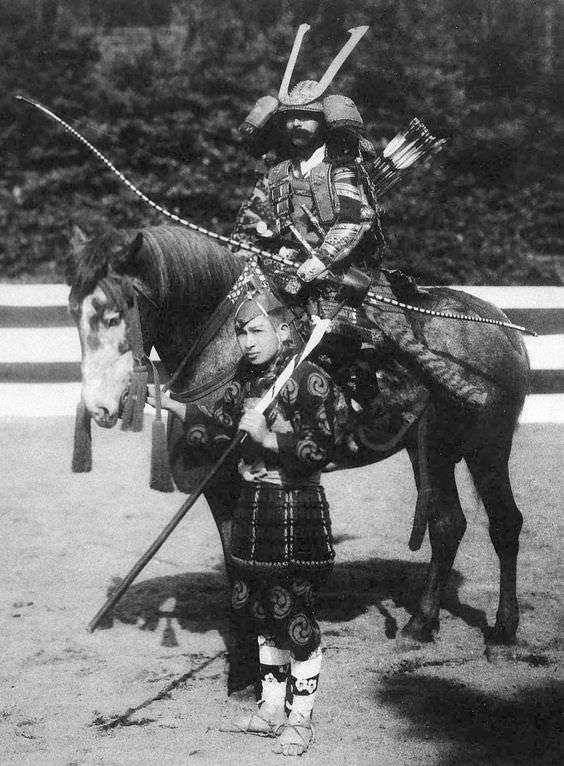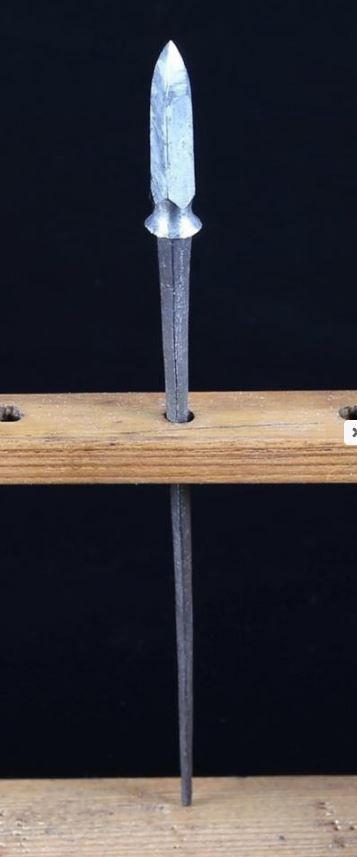An Original Edo Period, 1598 to 1873, Samurai Bowman's War Arrow {Tagari Ya} With Forged Steel Head, Sea Eagle Feathers, and Yadake Bamboo Haft
The arrow tip is a traditional tamagahane steel hand made long arrow head, with folding and tempering exactly as would be a samurai sword blade, possibly signed on the tang under the binding but we would never remove it to see. The Togari-Ya or pointed arrowheads look like a small Yari (spear) and were used only for war and are armour piercing arrows . Despite being somewhat of a weapon that was 'fire and forget' it was created regardless of cost and time, like no other arrow ever was outside of Japan. For example, to create the arrow head alone, in the very same traditional way today, using tamahagane steel, folding and forging, water quench tempering, then followed by polishing, it would likely cost way in excess of a thousand pounds, that is if you could find a Japanese master sword smith today who would make one for you. Then would would need hafting, binding, and feathering, by a completely separate artisan, and finally, using eagle feathers as flights, would be very likely impossible. This is a simple example of how incredible value finest samurai weaponry can be, items that can be acquired from us that would cost many times the price of our original antiques in order to recreate today. Kyu Jutsu is the art of Japanese archery.The beginning of archery in Japan is pre-historical. The first images picturing the distinct Japanese asymmetrical longbow are from the Yayoi period (c. 500 BC – 300 AD).
The changing of society and the military class (samurai) taking power at the end of the first millennium created a requirement for education in archery. This led to the birth of the first kyujutsu ryūha (style), the Henmi-ryū, founded by Henmi Kiyomitsu in the 12th century. The Takeda-ryū and the mounted archery school Ogasawara-ryū were later founded by his descendants. The need for archers grew dramatically during the Genpei War (1180–1185) and as a result the founder of the Ogasawara-ryū (Ogasawara Nagakiyo), began teaching yabusame (mounted archery) In the twelfth and thirteenth century a bow was the primary weapon of a warrior on the battlefield. Bow on the battlefield stopped dominating only after the appearance of firearm.The beginning of archery in Japan is pre-historical. The first images picturing the distinct Japanese asymmetrical longbow are from the Yayoi period (c. 500 BC – 300 AD).
The changing of society and the military class (samurai) taking power at the end of the first millennium created a requirement for education in archery. This led to the birth of the first kyujutsu ryūha (style), the Henmi-ryū, founded by Henmi Kiyomitsu in the 12th century. The Takeda-ryū and the mounted archery school Ogasawara-ryū were later founded by his descendants. The need for archers grew dramatically during the Genpei War (1180–1185) and as a result the founder of the Ogasawara-ryū (Ogasawara Nagakiyo), began teaching yabusame (mounted archery) Warriors practiced several types of archery, according to changes in weaponry and the role of the military in different periods. Mounted archery, also known as military archery, was the most prized of warrior skills and was practiced consistently by professional soldiers from the outset in Japan. Different procedures were followed that distinguished archery intended as warrior training from contests or religious practices in which form and formality were of primary importance. Civil archery entailed shooting from a standing position, and emphasis was placed upon form rather than meeting a target accurately. By far the most common type of archery in Japan, civil or civilian archery contests did not provide sufficient preparation for battle, and remained largely ceremonial. By contrast, military training entailed mounted maneuvers in which infantry troops with bow and arrow supported equestrian archers. Mock battles were staged, sometimes as a show of force to dissuade enemy forces from attacking. While early medieval warfare often began with a formalized archery contest between commanders, deployment of firearms and the constant warfare of the 15th and 16th centuries ultimately led to the decline of archery in battle. In the Edo period archery was considered an art, and members of the warrior classes participated in archery contests that venerated this technique as the most favoured weapon of the samurai.
The arrows are made using yadake bamboo (Pseudosasa Japonica), a tough and narrow bamboo long considered the choice material for Japanese arrow shafts called no. The black {now faded to brown} and white feather flights {hane} are likely Steller's sea eagle feather. Period 1599 -1863. it is the essential munition of an archer.
Ya used in war by the samurai had a variety of tips called yajiri or yanone; these arrowheads were forged using the same steel (tamahagane) and methods as traditional Japanese swords. There are many different kinds of arrowhead and they all have their own special name. Togari-ya is a simple pointed design. The yanagi-ba, also known as "willow-leaf", is known for its elegant design. Karimata have a unique split point, and are sometimes referred to as "rope-cutters". The barbed "flesh-torn" is known as watakushi. The tagone-ya is shaped like a chisel. Kaburi-ya was used for signalling and creating fear with the loud whistling noise it would produce.
Ya were large enough that they could be signed on the tang by the fletcher in the manner of Japanese swords.
The no are made from yadake bamboo and can have different shapes – straight or tapered – depending on the use of the arrow in long-distance shooting or target practice. Lighter arrows can lose their stability when shot from a strong bow, heavier arrows have a trajectory that arcs more. Typically they use bamboo from the Kanto area. This is for a purely practical reason: bamboo will not grow fast enough in a cold area and the joints are too close together, whereas in a warm area the bamboo grows too fast and the joints are too far apart; the Kanto area has a moderate climate which makes the joints the perfect distance apart. The joints of the shaft help with the balance. After harvesting, bamboo continues to change in size and shape so it must rest for 2+1⁄2 to 3 years after cutting before it can be used. When it has aged the proper time the bamboo should provide a good tight grip around the tang of the yanone. The bamboo is tempered in a special kiln similar to the Viking beehive style and straightened with a tool called a tomegi, or "tree tame", which is also used when creating bamboo fishing poles. The appearance of the no varies; some are plain, while others glisten with red lacquer. The proper length is measured from the archer's throat to five centimeters beyond the tip of the outstretched left hand.
Fletching
The arrows are fletched with hane (feathers) about fifteen centimetres in length, and originally when made fletching can be the most expensive part of the arrow. Traditionally, the outermost tail feathers of large birds of prey were considered the finest. Many of these birds are now endangered – in particular the sea eagle – and therefore feathers of lesser eagles, swans, geese or even turkeys are being used in modern times. On the other hand, owl feathers were never used, as they were thought to be bringers of misfortune. Feathers from either the left and right wing may be used; these wing feathers naturally curve left or right. Ya with feathers from the left wing are called haya and they spiral clockwise, whereas ya made from the right wing feathers are called otoya and they spiraled counter-clockwise.
Nock
The nock or hazu is often made from goat or deer horn and archers file the slot to match the diameter of their own bowstring. Older or ceremonial ya can have bamboo nocks.
The sea eagle feathers are somewhat tired and worn, but considering their age, likely 200 to 300 years old, they have survived very well indeed.
The last photo in the gallery is another, display mounted, Edo takari ya just to illustrate how long the tang would be on our arrow head that is concealed by the haft.
Code: 25356










